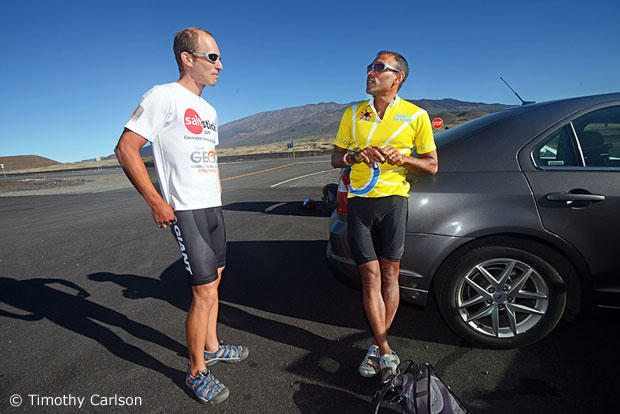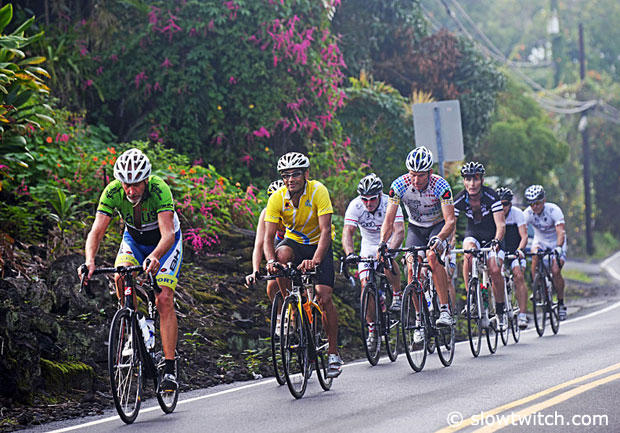Mauna Kea Triathlon – part 2
As we discussed in part 1, a triathlon does not need to be put on by someone else that you register for, pay for, get timed at and get finisher gear. Just like a run, a swim or a bike ride, a triathlon can be self-generated.
Jean Lacroix, an age group triathlete from Ottawa Canada was also intrigued by the concept of a triathlon to the summit of Mauna Kea. On the week of the Hawaii 70.3, he went out for his own mission, trying to figure out the logistics around a summit attempt. Jean has a 4:50 Ironman bike split to his credit, so he’s a reasonably strong cyclist by the measure of what constitutes “fast” in the masters age group divisions.
His main problem was lack of gearing and too much weight, showing up for his Mauna Kea recce 30 lbs overweight and with a 39×25. He basically had the worst of both worlds when it comes to this mountain. On his climb day, with a straight climb right out of Waikaloa, Jean made it up to 10,000 feet, riding his road bike to the Mauna Kea access road and then doing another 4000 feet up on a mountain bike. Eventually past the visitor centre, on a day with insane winds, he realized that at the rate he was going, he would not make it to the summit and back down the mountain before nightfall. He had a moment of support from his spouse during the bike change, but then he was solo for the rest of the day and needed to actually make it back before falling prey to bonking and becoming part of the Mauna Kea landscape’s potential road kill.
As we know the winds on the island are the big wildcard. Being heavy and with the wrong gearing, added to Lacroix’s challenge. In the end, like those attempting to make the Everest Summit, the mountain must be respected. We don’t make great decisions once we cover 10,000 feet in a single day. Fatigue, potential hypoxia and cold can all get in the way of good decision making, and thus kudos to Jean on his attempt. He learned what is needed to make this summit in the failed attempt, but in reality, any endeavor is successful when we learn from it and we applied some of what he learned to our own mission.
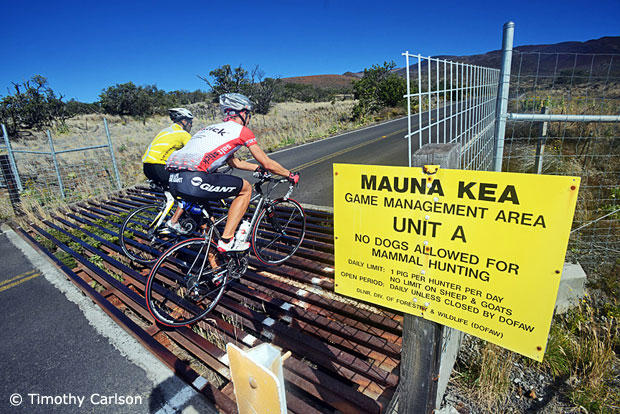
Our crew had some limitations in terms of time. Tim Carlson needed to be back at Kailua Pier on the same day to take photos of the pro bike check in, so our team would have a bit of a cheater format in that we started the endeavor with a car ride to 6000 feet above sea level, driving out of Kailua pier at 6:30 straight up Palani to Hawaii belt road, then a right turn onto saddle road and then a left turn onto the Mauna Kea access road. In fact, the directions from Kailua Pier to the summit of Mauna Kea are simple as drive 40 miles, right turn onto saddle road, drive 16 miles, turn left on Mauna Kea Access road, drive 13 miles to summit.
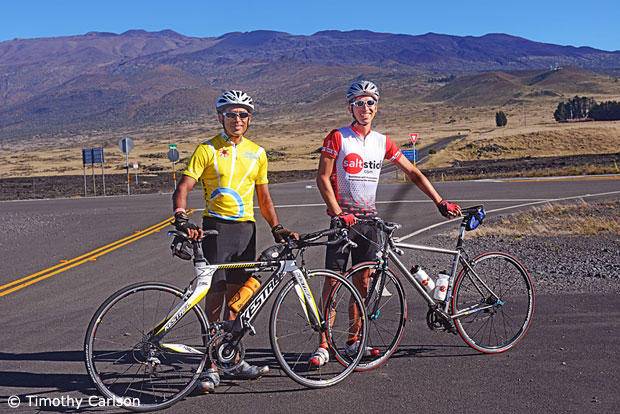
The original plan for the mission was the Mauna Kea 10,000 triathlon which would be a swim in Kailua Bay, a ride on Hawaii Belt Road, Saddle road and then up to the Maua Kea visitor center and then a final 700 feet of vertical running over approximately 1 mile on the 15% gravel road that starts just after the visitor center. This would take us to 10,000 feet. After talking with several athletes with experience this is possible with good fitness and no major modifications to a standard tri or road bike except for a compact crank and an 11-32 cassette with some moderate fitness. 11-27 and compact for those with superior fitness.
Riding past the visitor center where the pavement ends means having to use some type of a cylocross or mountain bike. But this is also a major penalty if one wants to try to ride from Kailua Kona all the way with the winds and the extra weight. So a tri bike to the visitor center and then running past that point seemed to make sense, however, when putting together a challenge that appeals only to the borderline lunatic fringe, nothing really makes that much sense.
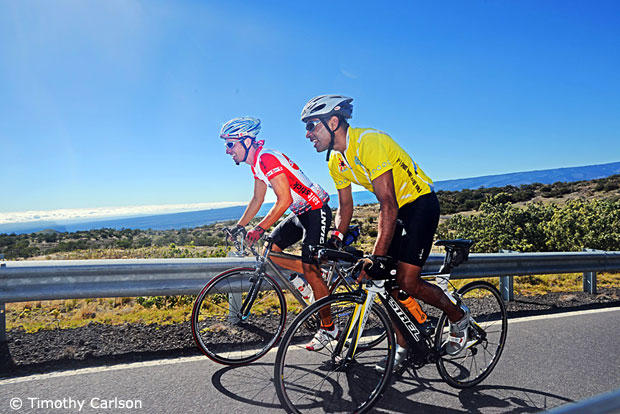
But that is also how the Hawaii Ironman started in the first place. As endurance athletes, we are good at bringing things that are in the realm of impossibility, into the realm of possible. Back to the logistics, if the gravel road could be run then perhaps one could revert to biking past the gravel section when the pavement resumes for the final 2 miles to the summit. This assumes that one has a support vehicle. This is Hawaii and while one event on the island allows for no outside assistance (The Hawaii Ironman World Championships), the Ultraman requires outside assistance. So it seems that any Mauna Kea tri should require a support crew to get you safely off the mountain.
Our starting point of 6000 feet was already way above the clouds and the humidity at lower altitudes. There is a parking lot at the bottom of the Mauna Kea Access road and this spot literally sits in the saddle between Mauna Kea and Mauna Loa both towering almost 8,000 feet above this spot. But for those of who have been in the Rockies, or the Alps or Dolomites, both of those mountains are deceptive.
From the saddle, they don’t look steep, and they don’t look high. But they are.
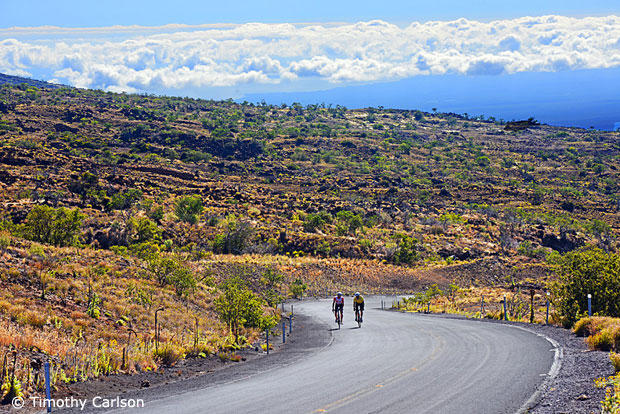
The first few pedal strokes at 6,000 feet up were a bit troubling. Andy Potts would be fine coming over from Colorado Springs. Those of us coming from sea level had a bit of a shock. For some reason thoughts immediately veered to sea level athletes planning to do Ironman Tahoe. But that is another topic. Our new plan was riding to the visitor center, and then running up as far as we had time for. Then get a lift back down as the winds were crazy and then ride the bike back to Kailua Kona via Hawaii Belt Road, ending with a swim in Kailua Bay. It was a bit of a jumbled triathlon starting with a 5000 foot climb on bike and on foot. But a good multi sport day nonetheless. A triathlon does not need to always be swim-bike-run in that order.
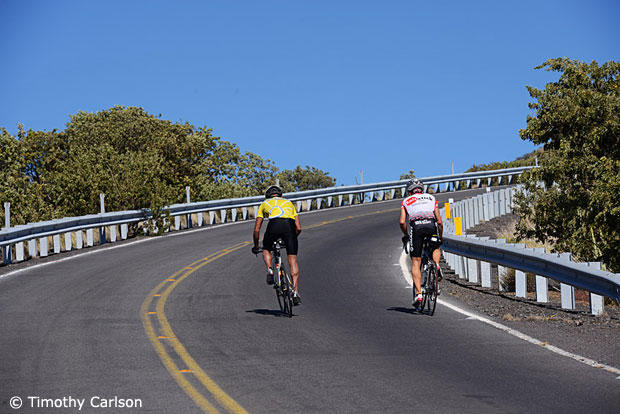
Between lack of air, and the severe steepness, this single stretch of tarmac on the Mauna Kea access road was the hardest single climb I had done and that includes plenty of experience in Europe as well as on Mount Fuji in Japan. The grade varied between 8 and 17% for 6 miles to the visitor center over which it climbs 3,300 feet. The stats don’t do the mountain justice. With the howling wind and lack of air, there were times that the speed dropped below 3 mph, cranking in a 34×32, literally out of breath. Way down below us you could see the clouds over the Pacific Ocean on the Hilo side. We were way above that, in dry air in crystal blue sky. A place with this level of visibility is hard to find. Perhaps this is why Mauna Kea is the home of some of the most powerful telescopes that man can build to observe the universe way beyond our tiny planet. We were riding this climb relatively fresh. If it was preceded by 4-5 hours and 6000 feet of climbing out of Kona, the level of difficulty would be further amplified. On second thought, perhaps a triple is needed for most mere mortals if doing the full ride. We took 68 minutes to make it to the visitor center, but you can probably add another half hour for this leg if riding all the way from Kona.
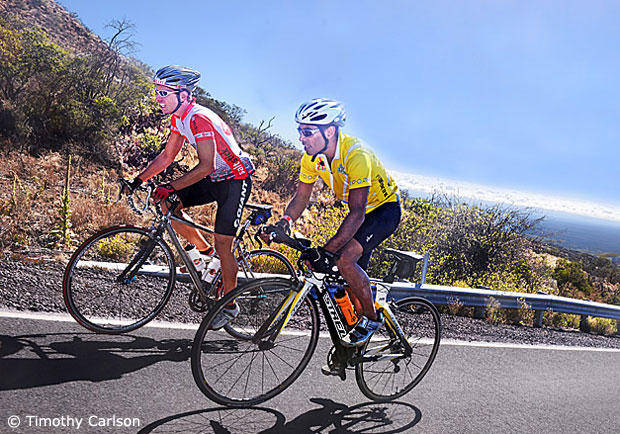
For this trip, we made T2 just beyond the visitor center. Tim Carlson pulled up in the official team vehicle. The bikes were loaded in, nutrition and running shoes came out and we were off running the 15% gravel section. Gravel is not the best description. It is more like a ground up lava and dust mixture. Moon dust is a better description.
The scenery from this point in the climb was incredible. It is a complete other world in this part of Hawaii, with beauty that is unique to the topography. You are above the clouds, but can see underneath them. You’re higher than anywhere else in the Pacific Ocean, yet you have a lot more climbing to do. You have hardly any oxygen, yet you feel energized.
Amazingly, losing the extra 20 lbs of bike, helmet and shoes made running up the 15% gravel grade feel easier than the riding we had just completed on the tarmac. Perhaps this is because you can choose your gearing while running. On the bike, being locked into the 34×32, the only way to modulate effort was with less or more RPM. Running up the gravel, we were able to change stride length and cadence, going from a fast shuffle to a slow shuffle to a glorified hike masquerading as a run. Well, if the definition of running is the inverse of race walking, then we can say that yes, we did run. But calling it running was a loose description. In race walking one foot must always maintain contact with the ground so by definition in running you must take flight by have no feet on the ground, even if it is for an instant. On Mauna Kea, at times it felt like both feet were simultaneously on the ground, but who cares?
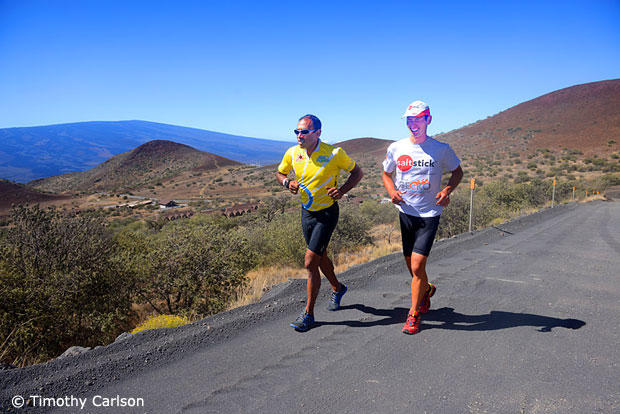
We considered running the entire 5 miles of gravel but were running out of time, as our photographer needed to be back in Kona for the bike check in for the Pros. It took us 30 minutes to cover 2 miles, so yes, the pace was only 4 mph, but we did cover almost 1,600 feet of vertical in the space of 2 miles. From there, the visitor center way below at 9,300 feet seemed like a toy house. It was time to turn around. We got a feel for what a run/hike/scramble would feel like. It would probably be necessary to allocate 2.5 – 3 hours on fatigued legs to do the entire run, keeping in mind that it might be a good idea to stop for a few altitude acclimatization and nutrition stops along the way up.
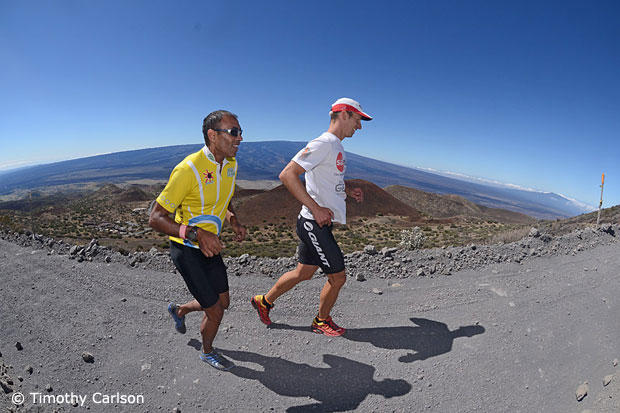
The two participants look quite happy and pose for a picture.
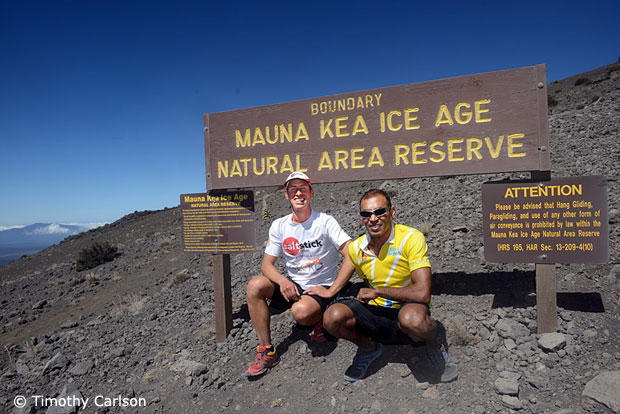
Jonathan Toker is ready to take flight.
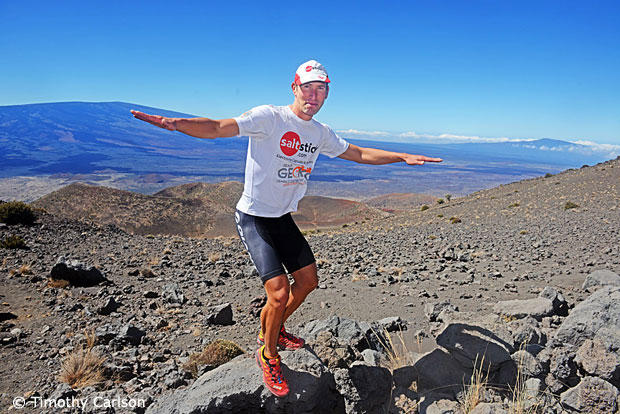
What goes up, can come down.
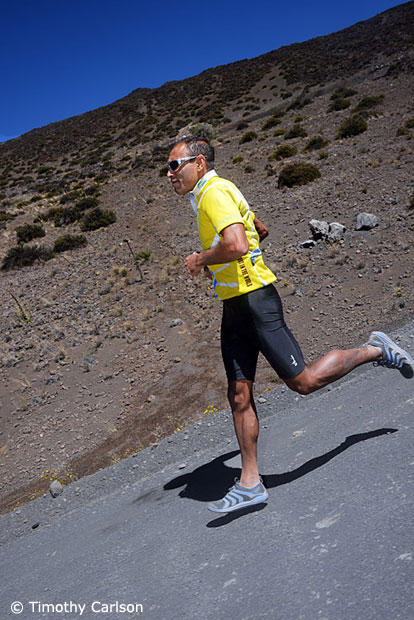
The trip was completed with a drive down to 2500 feet from where Hawaii Belt road was ridden on the bike all the way back to Kailua Pier. Hawaii belt road is definitely a very nice smooth road with a shoulder that is around 2 feet wide making it quite safe. The Hawaii Belt road basically parallel’s the QueenK, only thing is that it basically rolls in between 2500 and 2000 feet above sea level until it gets within 10k or so of Kona. Then it is a very quick downhill that turns into the famous Palani Hill connecting to Kailua Pier. Closing the day with a swim in Kailua Bay, complete with being stung by jelly fish just to remind us that we humans are just another part of the food chain, renting time and space on this earth during our lives. The Pacific Ocean and the volcanoes of Hawaii were here long before we came to this earth and will be here a long time afterwards.
So would the Mauna Kea 14,000 Triathlon even be possible? It would be 1 mile of swimming, 64 miles of riding with 9300 feet of climbing and then a final 7 miles of running with another 3400 feet of climbing. To help you visualize it, imagine running up Alpe d’Huez after coming into T2 the only problem is that you’d be starting at 9300 feet up!
Well, we have to believe that it is possible to make it possible. It would require Ironman finisher type fitness given that the day would likely last around 10 hours and probably well higher than 3.75W per kilo of power on the bike, gearing of 34×32 (or triple), a support crew and a day worth of nutrition for the athlete and crew. View it as a triathlon expedition that takes you from a base camp at Kailua Pier 16,000 feet above the ocean floor to the mountain summit at 30,000 feet above the floor of the ocean. No doubt, there are many who do this route in cars and tour buses. A few strong athletes have biked the entire distance. But has anyone used a triathlon to get to the summit? We don’t know, but we don’t think there has been anyone yet and given that Kona is the spiritual birthplace of triathlon it would only be fitting if someone got to the summit of the Volcano that towers above the island. So who will be the first? Fortunately in doing the job of ill fated Mallory in paving the way for Hillary and Tenzing on Everest, we came back just fine and more than a few have already expressed interest in making this triathlon expedition to the peak of Mauna Kea happen at some point in the future.
About the Author: Devashish Paul is reporting for Slowtwitch.com and contributing to topics related to age group lifestyle and was the third wheel in the Slowtwitch.com team on Mauna Kea along with Jonathan Toker and photographer Timothy Carlson.


